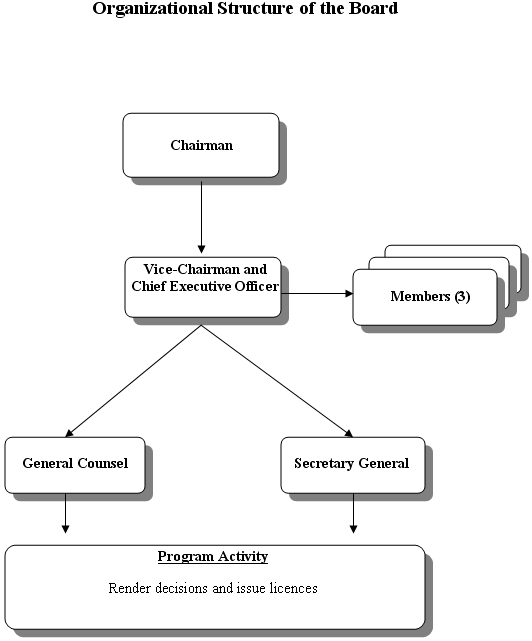Common menu bar links
Breadcrumb Trail
ARCHIVED - Copyright Board Canada
 This page has been archived.
This page has been archived.
Archived Content
Information identified as archived on the Web is for reference, research or recordkeeping purposes. It has not been altered or updated after the date of archiving. Web pages that are archived on the Web are not subject to the Government of Canada Web Standards. As per the Communications Policy of the Government of Canada, you can request alternate formats on the "Contact Us" page.
SECTION IV: OTHER ITEMS OF INTEREST
Organizational Information
Role
The Board is an economic regulatory body empowered to establish, either mandatorily or at the request of an interested party, the royalties to be paid for the use of copyrighted works, when the administration of such copyright is entrusted to a copyright collective society. Moreover, the Board supervises agreements between users and licensing bodies, issues licences when the copyright owner cannot be located, and may determine the compensation to be paid by a copyright owner to a user when there is a risk that the coming into force of a new copyright might adversely affect the latter.
The Board has powers of a substantive and procedural nature. Some powers are granted to the Board expressly in the Act, and some are implicitly recognized by the courts. The Board is a court of record and has powers to hold hearings and issue subpoenas.
Responsibilities and Organization
Board members are appointed by the Governor in Council to hold office during good behaviour for a term not exceeding five years. They may be reappointed once.
The Act requires that the Chairman must be a judge, either sitting or retired, of a superior, county or district court. The Chairman directs the work of the Board and apportions its caseload among the members.
The Act also designates the Vice-Chairman as Chief Executive Officer of the Board. He or she exercises direction over the Board and supervises its staff.
The organizational structure of the Board follows the requirements set out in section 66 and following sections of the Act.
The Board's Staff
The Board has a staff of twelve employees, two of whom report to the Chief Executive Officer: the Secretary General and the General Counsel.
The Secretary General plans the Board's operations, serves as its Registrar, represents the Board in its relations with members of parliament, provincial governments, the media and the public and directs the preparation of the Board's reports to Parliament and to the federal government's central agencies. The Secretary General is also responsible for managing and directing the economic research, analysis and planning functions as well as the registry and administrative and financial support functions.
The General Counsel provides legal advice on tariff and licence applications before the Board. The General Counsel also represents the Board before the Courts in matters involving its jurisdiction.

The Board has 17 Full-Time Equivalents (5 Governor in Council appointees and 12 employees).
